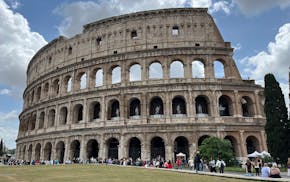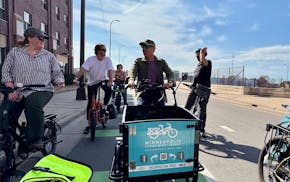Josie Johnson had always felt a bit of hope.
She stayed hopeful as a teenager in Texas, gathering signatures on a petition to end the poll tax. Hope drew her from Minneapolis to Mississippi during the fight for voting rights. For decades, she marched and organized in the hope her children's children would grow up in a different world.
Her children have grandchildren now. And after more than six decades of tireless civil rights work, Josie Johnson watched a policeman in her city casually crush the life out of George Floyd on camera.
"My hope was drained that day," said Johnson, who chose "Hope in the Struggle" as the title of her biography.
Minneapolis was burning, as it had burned in race riots before. Crowds took to the streets, protesting like so many had done so many times before.
Johnson found herself "trying to remember what we've been fighting for and what might need to be different in this struggle."
But something in this moment did feel different. Hope broke through the hurt. For Johnson, it came from the energy she felt from the young people in the streets, taking up the fight to build a better world for her great-grandchildren.
"This excitement I have felt of our young black boys and girls, men and women," she said. "That spirit and strength of our people keeps some of us fighting and being hopeful."
For historian Mahmoud El-Kati, the breakthrough moment came when he heard about the Black Lives Matter march in Pocatello, Idaho.
"If you don't understand the story behind the story, you don't understand the story," said El-Kati, a professor emeritus of history at Macalester College in St. Paul.
There was something about the sight of the policeman, smirking at the camera, ignoring the cries for help and for air from the unarmed man under his knee, that gave some white Americans their glimpse of the story behind the story. So this is what it's like, some realized, watching the video, then watching police attack peaceful demonstrators night after night. So this is how it feels.
"The fact that I'm talking to you now and not some statistic is only by the grace of God. That's a possibility for every black man," said El-Kati, author of "The Myth of Race, the Reality of Racism."
Watching that hard truth play out on camera "shook certain quarters in the white community," he said.
The question now is what the community does with that new insight into the white supremacy woven into its history and institutions.
"Whatever happened to the civil rights movement?" August Nimtz Jr., professor of political science and African-American and African studies at the University of Minnesota, used to pose that question to his students. The tongue-in-cheek answer: "Out of the streets and into the suites."
Now his students are out in the streets, getting a better education than any classroom could offer.
The long view of history offers a depressing view of history repeating. The lynchings of a century ago, the assassinations of half a century ago, the black men killed by police last week, last month, last year.
But the long view of history also shows of just how fast things can change. Nimtz joined the first George Floyd protest — a calculated risk for a 77-year-old African-American man in the middle of a pandemic.
"It was almost like a moment of liberation," he said. "We had come up for air."
Nimtz has seen other movements fizzle out over the years, often at the urging of community leaders — the people in the suites — who urge activists to exercise their power at the voting booth instead.
"I tell my students, if you think the most important thing you can do is vote, how did someone like me, who at one time could not vote, get the right to vote?" Nimtz said.
The first time he tried to vote, in 1964 New Orleans, he was turned away because of the color of his skin.
"Four years later, I was able to vote. You have to ask yourself, what happened in between?" he said. "It's because people like me and our allies had been in the streets. That's the way."
Josie Johnson's father wanted to be a lawyer, only to have his dreams crushed in the segregated South.
You have to keep on keeping on, he taught his daughter.
"At my age, those who have been in the struggle, we've seen it, we've known it," she said. "And we too have to keep on keeping on."
jennifer.brooks@startribune.com • 612-673-4008

Brooks: America mints its last penny. What's the new going rate for our thoughts?

Brooks: From big beavers to little bears, meet Minnesota's newest state symbols

Brooks: Kristi Noem's 'Hunger Games'? It could actually happen.

Brooks: Will American tourists abroad be welcome, or at least tolerated? I found out.

